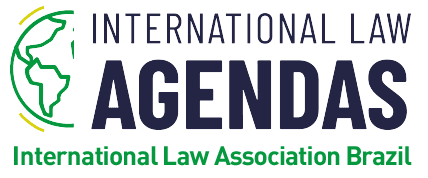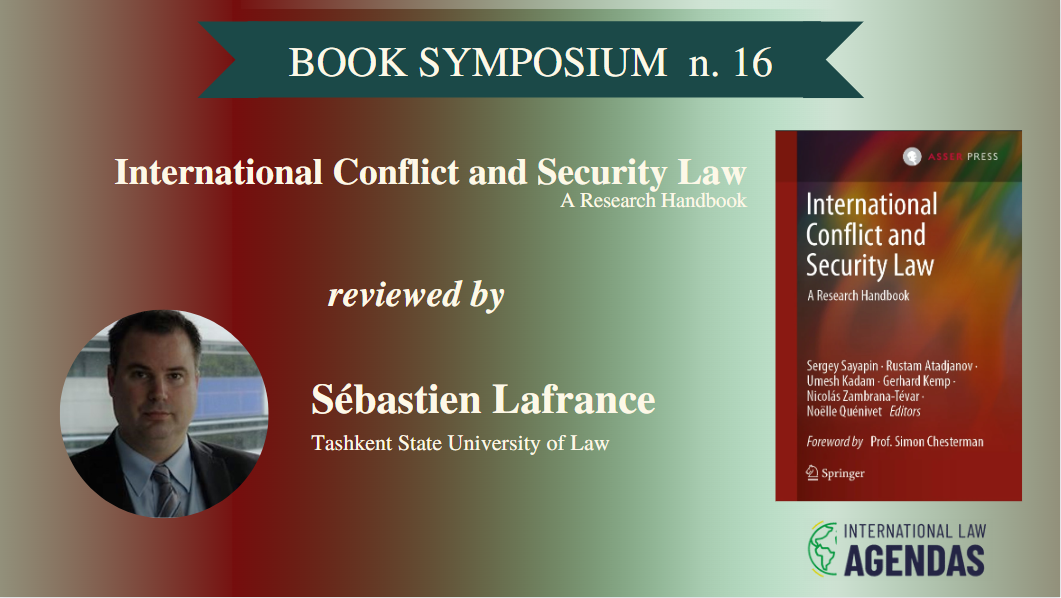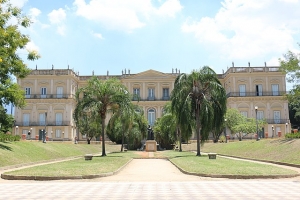The volume under review is a comprehensive coverage of various topics related to international conflicts and security law. The range of topics included in this book is impressive. It contains 64 chapters in total. For the purpose of this review, I endeavored to focus on the question of self-determination. This is the main subject of both chapter 2, written by Boris Kashnikov, titled “Self-Determination of Peoples”, and of chapter 41, written by Elizabeth Chadwick, titled “The Use of Force in Pursuance of the Right to Self-Determination”. Although a plethora of publications already exist on self-determination in international law, mostly because “[s]elf-determination is one of the fundamental principles of contemporary international law” (Kashnikov, p. 27; Case Concerning East Timor (Portugal v Australia) Merits, Judgment, ICJ Reports 1995, 4, para 29), these two chapters are more than just another publication on that topic. They rather contribute to the necessary discussion, and debate, that must, still, be had about it since “there is debate about nearly every aspect of self-determination” (Gentian Zyberi, ‘Self-Determination through the Lens of the International Court of Justice’, Netherlands International Law Review, 56, 2009, p. 431).
At first glance, it may be difficult to see what brings together the concept of self-determination and international security issues, but the two following examples should illustrate the clear connection that exists between them. First, an indirect connection would be that self-determination, if applied strictly, could give the possibility to every single ethnic, cultural, linguistic, etc. minority on the planet to eventually become a State. If so, this could “lead to the political explosion of planet Earth” (Yadh Ben Achour, ‘Souveraineté et protection internationale des minorités’, vol. 245, in: Collected Courses of the Hague Academy of International Law, 1994, p. 388; translated from French by the author; Kashnikov, p. 39). Here, the challenge to security caused by self-determination would consist in putting the territorial integrity of all States at risk. Self-determination could, if understood as described above, impact on the existence itself of almost every single State, possibly causing their disintegration. Second, one of the reasons why it is useful to think about self-determination through a security lens is because, practically, “treating liberation fighters as terrorists creates more, not less, officially-recognised terrorism” (Elizabeth Chadwick, Differentiating International Terrorism and ‘Peoples’: Struggles for Self-Determination, GlobaLex, 2019). Therefore, the legal framework applied to qualify individuals either as liberation fighters or as terrorists may have serious consequences for a State as a whole, including for its security more specifically. This makes this legal framework essential to know in that context. Chadwick (p. 900-908) presents suitably the characteristics of that legal framework in a way that helps understanding the theoretical and practical tensions that exist between the application, to the same conduct for example, of either domestic criminal law or international humanitarian law via the reliance on the principle of self-determination.
No one is against virtue. Self-determination is, in principle, a noble and laudable idea. However, Kashnikov (p. 27-28) aptly points out that this concept as it is applied is “full of gaps and inconsistencies”. His conclusion is that self-determination “has outlived its moral validity and should be regarded as a harmless anachronism at best, a harmful atavism at worst” (p. 28-29). As for Chadwick’s analysis regarding the right to use force in struggles for self-determination, it is quite useful in that it elucidates the legal differences between terrorism and self-determination since, in that context, “the issue of force is the most problematic” (p. 901), mostly because, in fact, “certain wars of liberation are legitimate” (J.E.S. Fawcett, ‘General Course on Public International Law’, vol. 132, in: Collected Courses of the Hague Academy of International, 1971, p. 487; Chadwick, p. 887; p. 898).
Summarily, “self-determination denotes the legal right of people to decide their own destiny in the international order” (Cornell Law School – Legal Information Institute; for a detailed definition, see e.g. Yadh Ben Achour, ‘Souveraineté et protection internationale des minorités’, vol. 245, in: Collected Courses of the Hague Academy of International Law, 1994, p. 387). Keeping in mind that “internal self-determination is intrinsically linked with the concept of sovereignty and external self-determination” (Xue Hanqin, ‘Chinese Contemporary Perspectives on International Law – History, Culture and International Law’, vol. 355, in: Collected Courses of the Hague Academy of International, 2012, p. 106-107), but that sovereignty clashes with the principle of self-determination (Kashnikov, p. 29), it must be emphasized that there is a difference between the right to internal self-determination and the right to external self-determination (Milena Sterio, Secession in International Law: A New Framework, Edvard Edgar Publishing, 2018, p. 25; Reference re Secession of Quebec, [1998] 2 SCR 217, para 216). The former provides for internal rights entitlements whereas the latter stands for an entitlement to secede (Chadwick, p. 901).
Chadwick (p. 897) claims that Resolution 2625 (XXV) of the United Nations General Assembly, which recognized the rights to self-determination, has “explosive consequences [because it] approved the right of peoples to use ‘all available means’ to achieve their self-determination.” A similar opinion was also expressed by Professor Anand about the application that should be made of self-determination. He wrote, “No territory … should be deprived of its right to choose independence, whatever the circumstances or consequences” (R.P. Anand, ‘Sovereign Equality of States in International Law’, vol. 197, in: Collected Courses of the Hague Academy of International Law, 1986, p. 167; emphasis added). That being said, the discussions held during the United Nations Conference on International Organization in 1945 allow us to see that there were two opposite positions regarding the scope of the principle of self-determination at the time when self-determination was negotiated to be included in what would become eventually the United Nations Charter. The following position, interpreted broadly, may basically be similar to Chadwick’s stance on this issue: “Concerning the principle of self-determination, it was strongly emphasized on the one side that this principle corresponds closely to the will and desires of peoples…” (Documents of the United Nations Conference on International Organization, San Francisco, vol. 6, 1945, p. 296; Budislav Vukas, ‘States, People and Minorities’, vol. 231, in: Collected Course of the Hague Academy of International Law, 1991, p. 377). However, “on the other side, it was stated that the principle conformed to the purposes of the Charter only insofar as it implied the right of self-government of peoples and not the right of secession” (ibid.).
With that backdrop in mind, Resolution 2625 (XXV) includes both above-mentioned positions, including a support for the sovereignty of States – and not only of the right to self-determination –, which is also provided by paragraph 2(4) of the United Nations Charter. Indeed, Resolution 2625 (XXV) also clearly states, “Nothing [in this document] shall be construed as authorising or encouraging any action which would dismember or impair, totally or in part, the territorial integrity … of sovereign and independent States” (p. 124). Therefore, we respectfully beg to differ with Chadwick’s opinion about Resolution 2625 (XXV)’s “explosive consequences”. Nevertheless, this does not make Chadwick’s chapter less interesting, quite the contrary.
Chadwick (p. 892-895) adopts a pedagogical approach for the first part of her chapter by introducing core concepts of international humanitarian law that are relevant for the study of self-determination in international law. Likewise, Kashnikov (p. 32-33) does a brief coverage of the historical background regarding the genesis of the concept of self-determination, about which most commentators trace it back to the American Declaration of Independence (1776) and the French Revolution (1789) (Budislav Vukas, ‘States, People and Minorities’, vol. 231, in: Collected Course of the Hague Academy of International Law, 1991, p. 364), even though it could be argued that it “goes very far back into the past” (Manfred Lachs, ‘The Development and General Trends of International Law in Our Time’, vol. 169, in: Collected Course of the Hague Academy of International Law, 1980, p. 43). Kashnikov also notes that self-determination only “surfaced within international legal discourse only in the 20th century” (Kashnikov, p. 34). He dedicates a substantial part of his chapter on what he calls the three movements that marked the evolution and different approaches to the meaning and application of self-determination (Kashnikov, p. 34-40). A similar approach has already been taken by another author (Patrick Mecklem, ‘Self-Determination in Three Movements’, Cambridge University Press, 2016), however Kashnikov (p. 37-40) goes one step further, in the context of the third movement that started in the 1990s, by explaining the foundations of the ethical theories that supports a justified secession, i.e. the choice theories, the nationalist theories, and the just cause theories.
Interestingly, on several occasions, one of the authors’ chapter that is reviewed here seems to echo the other and vice-versa, not by expressing the exact same ideas, but rather by complementing each other on a few elements of their analysis. Each of them does it from a different perspective, given their respective topics.
First, Kashnikov (p. 42) asks, “What are the means available for the overarching cause of self-determination? Is it terrorism, war or negotiations? The problem remains unresolved.” In the same vein, Chadwick states that “self-determination is conflated with terrorism” (p. 900). In addition, she argues that both these concepts are “distinguishable by their different means and methods” (p. 908). One might try to argue in response that this confusion has been clarified since we went from a time where “there [was] no legally recognized … definition of terror-violence” (Robert A. Friedlander, ‘Terrorism and Self-Determination: The Fatal Nexus’, (1980) Syracuse Journal of International Law and Commerce: 7(2), p. 263) to a time, now, where there are three anti-terror international conventions (Chadwick, p. 41), namely on terrorist bombings, terrorist financing, and acts of nuclear terrorism. However, these conventions contain “extremely broad definitions” (Chadwick, p. 903), which does not help to clear away such confusion. Therefore, “[t]he lack of global definitions only blurs distinctions between international terrorism and the right of ‘peoples’ to struggle for self-determination” (Chadwick, p. 906).
Second, another similarity between the two authors may be shown by their criticism of the notion of ‘people’ as understood by the principle of self-determination, which is one of its key component. Kashnikov (p. 41) states, “There is no answer to the question of what really makes a people” in spite of what has been suggested so far, including with “[t]he indeterminacy in the [United Nations] Charter regarding ‘which’ peoples are entitled to self-determination”. Chadwick (p. 889) argues in a similar way that “there are no centralised codifications detailing which ‘peoples’ are ‘entitled’ to [self-determination], and why.” This is true as far as the conventional legal instruments go. However, without being a perfect solution, as the six points of Margalit and Raz mentioned by Kashnikov are not (p. 41), it should not be ignored that “a two-prong [legal] test has been applied to determine when a group qualifies as a people” (Milena Sterio, ‘The Right to Self-Determination Under International Law: “Selfistans,”, Secession, and the Rule of the Great Powers’, Routledge, 2012, p. 16).
Additionally, Kashnikov (p. 27) states that self-determination “belongs to three overlapping realms: politics, law and ethics.” This assertion is not without foundations since Professor Jennings had stated several decades ago that “self-determination is not a single concept but a complex of factors, some of which imply policy decisions and some are relevant to strictly legal considerations” (R. Y. Jennings, ‘General Course of Principles of International Law’, vol. 121 in: Collected Courses of the Hague Academy of International Law, 1967, p. 432; p. 564). Self-determination then becomes a perfect example to show how different fields, in addition to law obviously, are intertwined intrinsically in international law.
In conclusion, these two chapters usefully add to the doctrine of public international law and the only way to do them justice would be to give them the attention they deserve. With the example of the conflation of self-determination and terrorism, among other things, examined with care by Chadwick, and with the study of issues related to the scope and meaning of self-determination itself, wisely discussed by Kashnikov, these chapters shed light on the importance of the relation that exists between international security law and self-determination.
This book will be of interest to students, scholars and practitioners of public international law, terrorism and national security, politics, international relations, and human rights.
-

Fellow, Central Asian Legal Research centre, Tashkent State University of Law, Uzbekistan. Adjunct professor, Universitas Airlangga, Indonesia. Adjunct lecturer, Ho Chi Minh City University of Law, Vietnam. Crown Counsel (Prosecutor) at the Public Prosecution Service of Canada. LL.M. in Criminal Law (with Honours / Merit List), Laval University. The views, opinions and conclusions expressed herein are personal to this author and should not be construed as those of the Public Prosecution Service of Canada.





